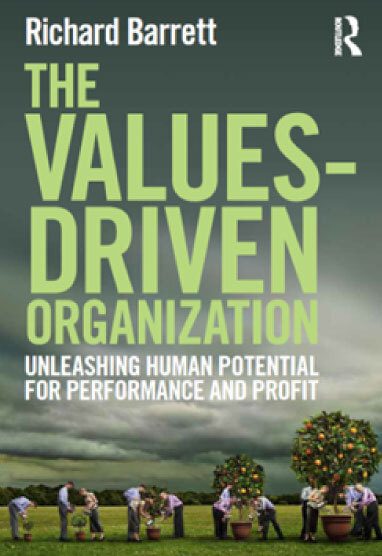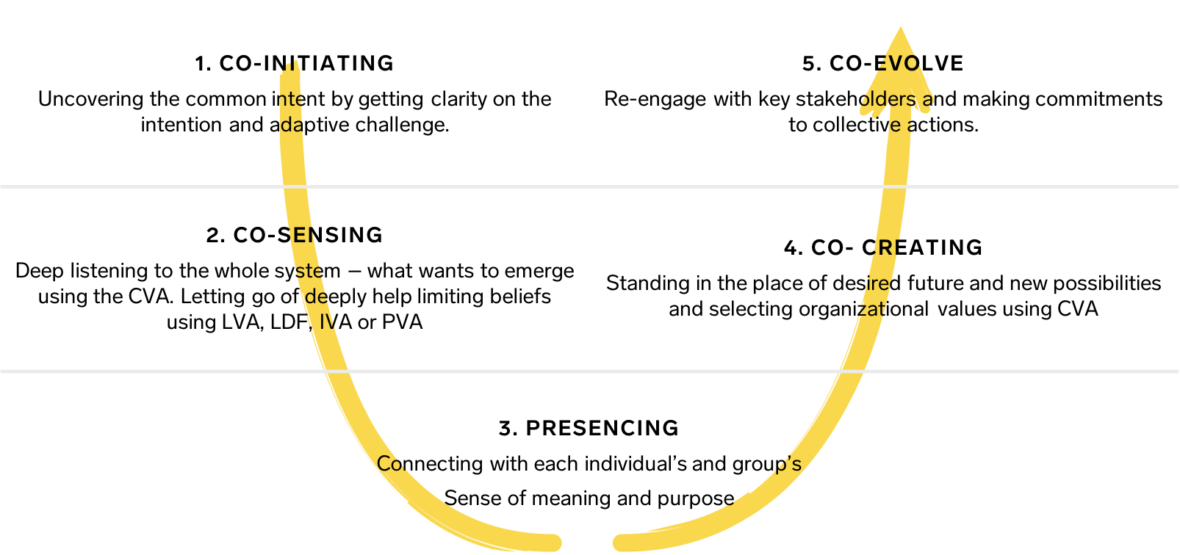
Theory U and Levels of Consciousness
BY Lisa Doig
Insights
In 2016, Richard Barrett invited Lisa Doig to share an annex in his latest book, a Values-Driven Organization. This annex includes a case history on the integration of Theory U with levels of consciousness.
Theory U is a profoundly impactful transformational methodology for solving adaptive challenges at a systemic level. Theory U started in 2006 as a ten year research project by Otto Scharmer and his colleagues at MIT Cambridge. Other contributors included Peter Senge and Joseph Jaworski.
Theory U can be understood in three ways: as a framework for organising thinking; as a method for leading profound change; and as a way of being—connecting to the higher aspects of self.
The fundamental idea behind Theory U is that the quality of the results that we create in any kind of social system is a function of the quality of awareness, attention, or consciousness that the participants in the system operate from. In other words, the outcomes we create are a function of the levels of consciousness we operate from. In the Barrett Whole Systems Change methodology, the U-Process can be used for any of the steps from Executive Team Transformation to a whole systems change process to choose the values of the organisation. At Corporate Evolution Pty Ltd. we use the U-Process for all our workshops and interventions.
Five Stages of Theory U

Theory U provides a set of principles and practices for creating the future that wants to emerge. Rather than continuous improvement based on incremental changes, it senses into and listens into the future through the use of “presencing”. The term, presencing, is an integration of "presence" and "sensing," referring to the ability to sense and bring into the present one's highest future potential—as an individual and as a group. Presencing allows those taking part to access their intellectual, emotional, mental, and spiritual capacities.2
There are five stages to the U-Process. The image below explains how each stage relates to information provided through the use of the Barrett Cultural Transformation Tools.
Otto Scharmer, the originator of the Theory U states “successful leadership depends on the quality of attention and intention that the leader brings to any situation.” This is the most important part of the U-Process—helping leaders direct their attention and intention from the head, to the heart and to then learn to listen to the space in between; their own knowingness—the future that is desiring to emerge.
It takes the participant through a journey: first at the level of the IQ (intellectual intelligence)—open mind, then at the level of EQ (Emotional intelligence)—open heart, and finally at the deepest source of meaning, the level of SQ (spiritual or meaning intelligence)—open will. This practice, in itself is profoundly transformational.
The five stages of the U-Process map to the Barrett/Wilbur Whole Systems model shown in Figure 4.4. The interventions weave in and out of leading self (left-hand quadrants) and leading others (right-hand quadrants). First we descend into the interior of the individual; then the interior of the group where collective presencing takes place. Then we ascend into the exterior of the group; then to the exterior of the individual.
Client Examples
Case Study 1: Private Equity Firm
Business challenge: Adapt to the rapidly changing business environment so we can sell companies faster.
Over a two year period, Corporate Evolution worked with a private equity firm to improve their culture and business performance. Phase 1 interventions (using the U-Process design) included Director level workshops to align on the desired culture and values. This included listening to all their stakeholders (investors, CEOs, employees, Board, Partners) 360 debriefs on their leadership, a deep dive on leadership transformation frameworks and individual monthly coaching. The output of the first two workshops created the foundation of a High Performing Team and commitment to their personal transformation as Leaders.
One year into the program, the Team continued their Leadership Culture Journey into Phase 2, by applying their transformational mindsets to their biggest adaptive challenges. The most urgent business challenge was: “How do we sell our Companies faster?". While the Firm had a demonstrable track record in acquiring companies, at that time, it had not sold any of its companies for 15 months.
We continued the integration of the U-Process as the design framework, as both the client and the participants saw the power of the "U" – the letting go and letting come required to truly transform the challenge. A two-day U-Process workshop on "Selling Our Companies" was designed to help surface the blockages, emerge new mindsets and work together in new ways towards actioning selling companies.
By this time the team was tangibly more open and trusting with each other, which meant that the quality of dialogue was "edgier" (balancing challenge with support for each other).
The turning point of the workshop, as with all U-Process workshops is bottom left and bottom of the U – where personal transformation takes place. When we integrated all the personal transformation skills from the previous workshops, and asked team members to coach each other with our transformation coaching tools, what emerged were totally new ways of looking at the “problem” and their part in it. New insights and new mindsets emerged– not from the head, but from the heart and the courage that came when they connected with their values and purpose.
Results
There were significant mindset shifts in this workshop and relationships which were strained, were re-united. One executive provided this feedback, “Our conversations as a team are more real, more powerful and more effective as a result of the confidence we have with each other now.” Within 6 months the firm had sold two more companies. The culture became one of the distinctive benefits of the Firm.